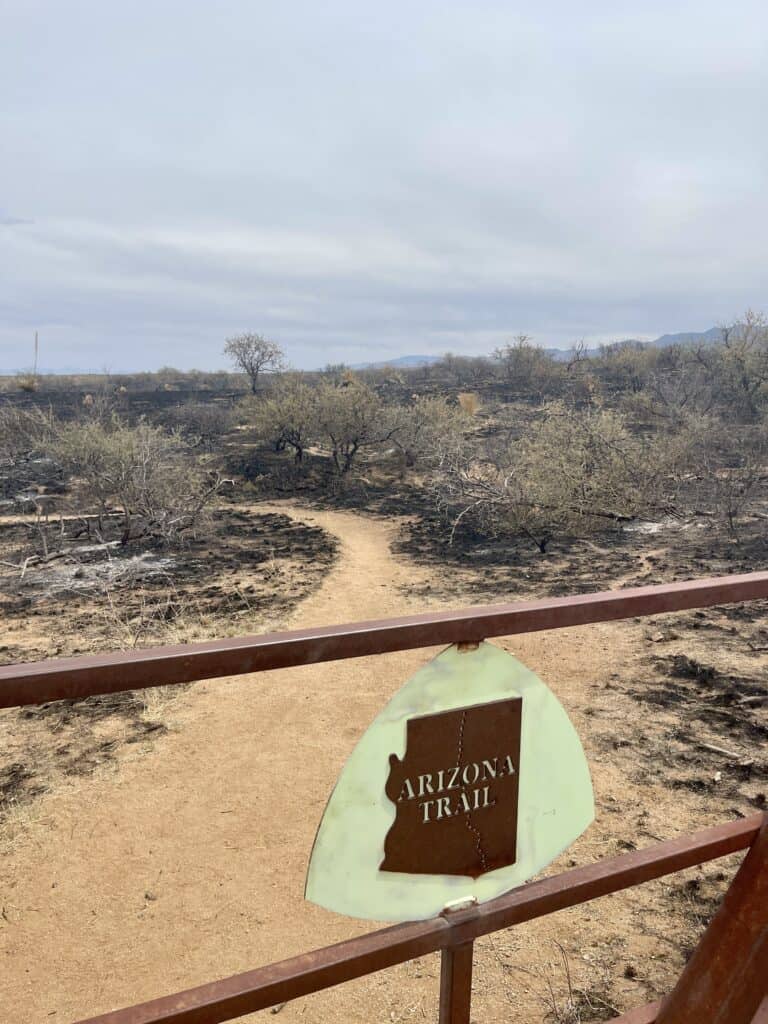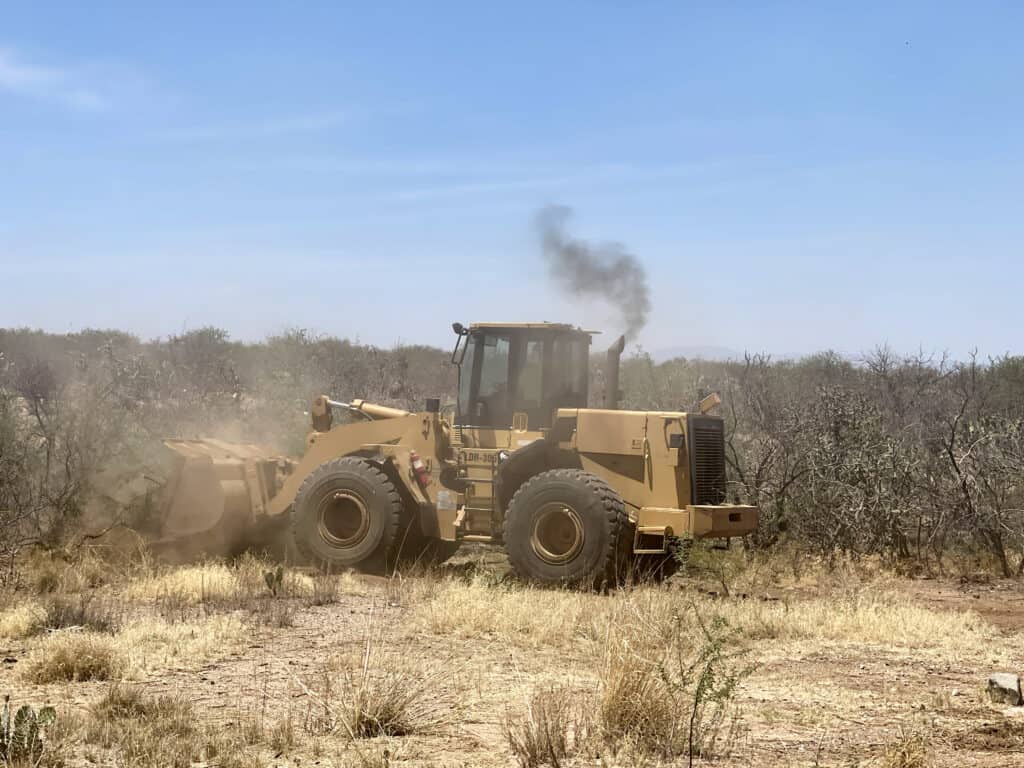
Parts of the Arizona Trail were burned during the recent Cody Fire near Campo Bonito, Oracle and San Manuel. Photo by T.C. Brown
The recent Cedar Fire and Cody Fire were stark reminders that wildfires can happen at any time. The first responders and fire professionals all believe it is not a question of if, but when, the next wildfire will start in our area. There are several different fuels that would aid in the spread when we face the threat of fire again. Unfortunately, five homes were lost during the recent fires in and around Oracle. It was terrible for all, but it could have been worse.
“Every year, 9 out of 10 wildland fires are started by humans. So be the ‘one’ and help us and do your part to prevent wildfires in Arizona. In 2024, 2,162 fires burned more than 280,000 acres on state, federal and tribal lands. Of those fires, more than 1,400 were determined to be human-caused.”
“The Department of Forestry and Fire Management provides fire protection to 22-million acres of state and private lands. DFFM also provides suppression on other land jurisdictions through cooperative agreements. The agency maintains in-house fire command and firefighting capabilities, including engines, an inmate wildland fire hand crew program, and the Phoenix Crew, a Type 2 IA hand crew. Along with internal resources, DFFM has access to 2,700 wildland firefighters and 3,000 pieces of equipment from local and federal cooperating agencies.
“Along with suppression efforts, DFFM also conducts fuels reduction work annually across the state, including prescribed burning projects. Plus, DFFM works with Arizona communities, municipalities, and homeowners through the Firewise USA program to instill good practices of wildfire safety, defensible space, and other prevention methods.” https://dffm.az.gov/fire/suppression for more information.

BHP crew members were busy during the recent fires as they created and widened fire breaks around San Manuel. They have been clearing areas all around the area. Photo by T.C. Brown
“There is no ‘wildfire season’ anymore in Arizona. Fires can happen year-round. We stress the importance of prevention. We all need to work together to reduce wildfire risk across our great state.
“When working outdoors, always check the weather beforehand. Keep a water source and shovel nearby and never leave a burn unattended. If using any type of equipment that may throw sparks be sure its equipped with a spark arrester. When recreating – be a responsible camper. Know before you go – check land status and fire restriction information. If allowed – and having a campfire, put it out completely and make sure it’s cool to the touch before walking away. Drown, stir, and repeat.
“When towing a vehicle – take an extra minute to make sure tow chains are secure before hitting the road. Check your tires, as blowouts have been known to cause wildfires. And never pull off into tall grasses. The undercarriage of your car can get very hot and start a wildfire if parked in dry vegetation.
“And finally, protect your property. Create defensible space. Cut back trees, reduce dead fuels, keep your lawn cut and watered, and remove all flammable materials away from your home.” https://dffm.az.gov/fire/information for more information.
A Living with Wildfire guidebook specific to Arizona can be found at https://dffm.az.gov/sites/default/files/media/Living%20With%20Wildfire%20Booklet%20-%20REVISED%202021.pdf. Some of the ideas presented are included below.
‘Creating survivable space around your home is one of the most important and effective steps you can take to protect you, your family, and your home from wildfire. All vegetation, naturally occurring and otherwise, is potential fuel for fire. Plant choice, spacing, and maintenance are critical; where and how you plant can be more important than which species you use. Some important things to remember about plants are:
- No plant species is totally “fireproof”.
- Moisture content is the most important factor influencing flammability.
- Plants with high resin content tend to be most readily flammable.
- Many native plants in arid environments, such as manzanita, juniper, and pine, are resinous.
- Deciduous plants tend to be most fire resistant because leaves have high moisture content.
- Isolated or small groupings of trees or shrubs are best. Treat groups as individual vegetation units.
- Use boulders, flagstone, rock walls, and other non-organic hardscape materials to separate planting areas.”
THE SIX “Ps” OF IMMEDIATE EVACUATION:
- People and Pets! – And other livestock too
- Papers – Important documents
- Prescriptions – Pills and eyeglasses
- Pictures – Irreplaceable memories
- Personal – Information on hard drives, Computer tablets, phones, & disks
- Plastic – Credit cards, ATM cards, & cash”
Pinal County offers a notification system for all who sign up. It is called PENS.
WHAT IS PENS?
PENS stands for Pinal Emergency Notification System. It is Pinal County’s tool to notify residents of any impending or current emergency where action by residents may be necessary.
A PENS alert notifies residents when an emergency is immediately impacting their community, and they may need to take action. These notifications are usually reserved for more severe situations where life or property may be threatened. They can also be used in situations such as a weather alert or wildfire, where time is of the essence, and immediate notification is imperative.
Alerts are issued through phone, text, and/or email, depending on how you registered to receive your alerts. PENS can also be indirectly posted to County or departmental social media channels and can be sent according to any geographic boundaries necessary or be used as a countywide message blast.
Be sure to register for the Pinal Emergency Notification System (PENS). Once you register and create a profile, you can select your preferences for how and when you will receive alerts. Please register at https://pinalcounty.genasys.com/portal/en.
The San Manuel Revitalization Coalition has been working with the local fire district as well as state forestry and fire management on the needed steps that are required for San Manuel to become a Firewise Community. It is hoped that community members will attend upcoming meetings that will be announced in the future.
“During a major wildfire, it is unlikely there will be enough firefighting resources available to defend every home. In these instances, firefighters will likely select homes they can safely and effectively protect. Even with adequate resources, some wildfires may be so intense that there may be little that firefighters can do to prevent a house from burning. The key is to reduce places where embers can ignite the structure or adjacent fuels. Consequently, the most important person in protecting a house from wildfire is not a firefighter, but the property owner. And it’s the action taken by the owner before the wildfire occurs (such as proper landscaping) that is critical.”
Now is the time to prepare for the next wildfire.
